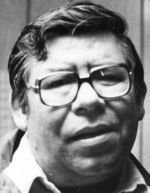 |
| Fools Crow, Oglala Chief [3] |
[2] John Kusiak, We Shall Remain: Wounded Knee, DVD, Stanley Nelson (2009: PBS), web.
[3] Otto Bettman, photographer, Frank Fools Crow at Wounded Knee Occupation, photograph, South Dakota: Corbis, March 6 1973, CORBIS Images: Bettman Collection, Web, http://www.corbisimages.com/stock-photo/rights-managed/BE054415/frank-fools-crow-at-wounded-knee-occupation (accessed March 26, 2012).
[4] Reinhardt, Akim D. Ruling Pine Ridge: Oglala Lakota Politics from the IRA to Wounded Knee. Lubbock, Texas: Texas Tech University Press, 2007.
[6] Kusiak, We Shall.
[7] Banks and Erdoes, 161.
[

